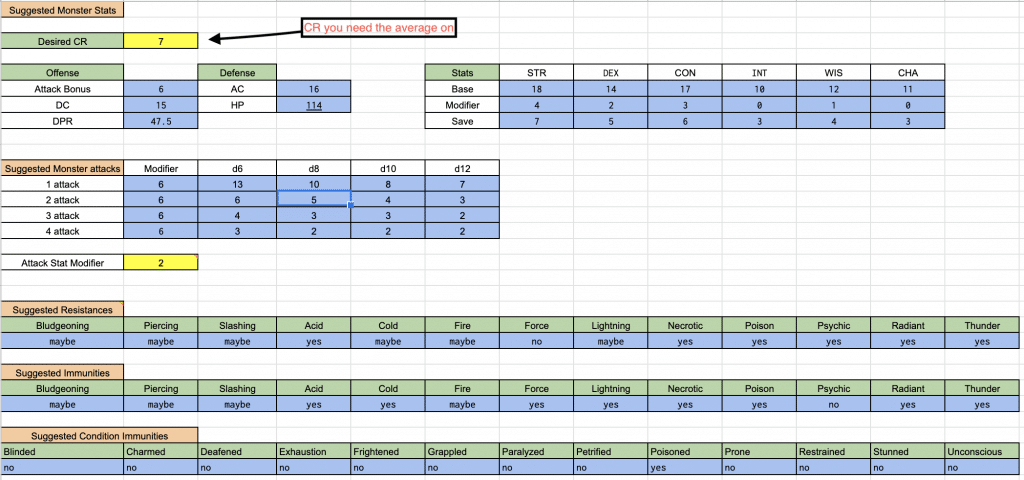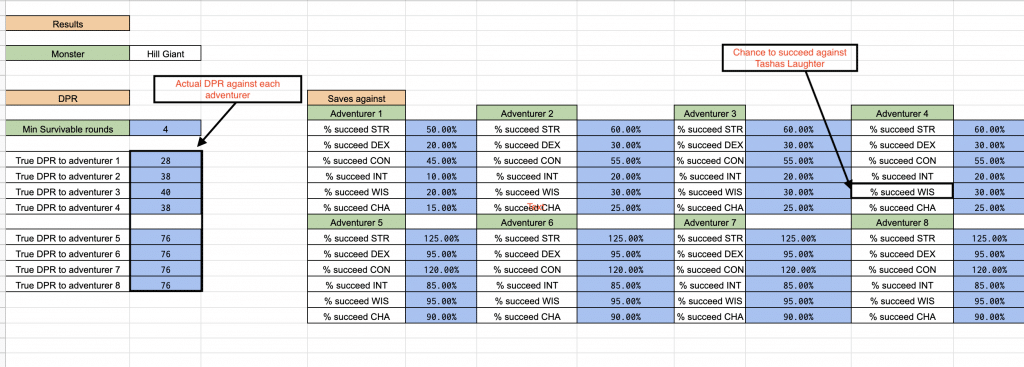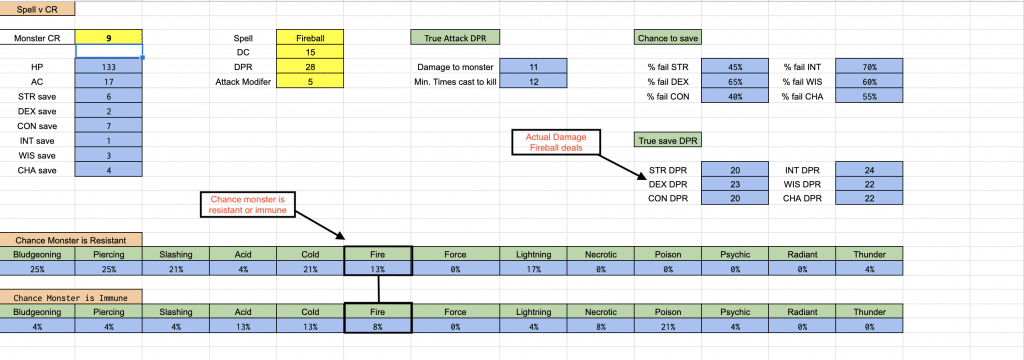You might have noticed a new tab called “Free D&D Calculator”. Well, that’s because I have spent hours fine-tuning and preparing a calculator that allows everyone to do a base analysis much like I do when I review something. This way everyone can be a wizard for their party and see just how good everything this. There are currently three calculators and each will be gone over in detail. One for Monsters, one for the party, and one for spells. Each will be gone over in detail below, so let’s begin.
Suggested Monster Creation D&D Calculator
The Suggested Monster Creation Calculator is for those that want to know what the average monster has for each CR and account for that in either building a monster or fighting a monster.
DM Purpose
There are two intended purposes behind this calculator. The first is for DM’s looking to see what kind of monsters they should build at what CR. For example, your party is suppose to fight a CR 7 monster. So in Desired CR box, you type in a 7. After that, you will be shown the average attack bonus, HP, DPR, AC, DC, as well as stats, saves, and resistances for the average CR 7 monster. That way you have a baseline for building a monster at that CR.
The second DM purpose, is to generate a monster on the fly. There are many times when your party is going to throw you for a loop and you will need to create a monster on the fly. Well, as long as you know the general CR challenge for your party plug it in and have an entire monster ready for the combat encounter with stats, attacks, HP, AC, and resistances. It’s a great resource for coming up with it on the fly.

Player Purpose
For players, it is a little bit more simple. If players know what CR’s they have the potential to fight. Then, they can see what to expect on average. While prepping or take it into account in the coming session or when they level up. Rather simple, but can be incredibly helpful for players who want to see what is coming.
Monster Analysis D&D Calculator
The Monster Analysis Calculator is great for DM’s afraid of making monster battles too easy or too hard.
DM Purpose
For DM’s this calculator is great for when you have a boss monster, custom monster, or enemy encounter and you want to see how your specific adventuring party will fair on average against them. This calculator will take the basic information such as HP, AC, saves, and highest DPR each adventure and monster can do. Then it will plug it in and calculate the true dpr for attack rolls, saves, as well as the chance to save each adventurer and monster will face.
Examples
For example, say you had a party of 4 adventurers at level 3. A deadly encounter against them would be roughly a CR 5, in other words, a hill giant, a hill giant has two attacks each dealing 3d8+5 damage. Meaning if both hit it will deal roughly 50.5 points of damage. Therefore, you would plug 50.5 into DPR. After that, you would plug into the Hill Giants to hit (+8) in Attack Modifier and plug in your adventuring parties AC, in this case, 19, 15, 14, 15.
After plugging in these numbers it will automatically generate the true DPR a hill giant has per turn. Dealing on average 28 damage to the AC 18 adventurer, 38 to the two adventurer with 15 AC, and 40 points of damage to the adventurer with 14 AC.

Now let’s say you have a wizard in your party who loves to cast Tasha’s hideous laughter. An effective spell for stopping many foes. Well plug in your wizard’s spell DC, and then plug in the hill giants wisdom save. In the Saves Against section, go to whatever adventurer slot you plugged in the wizard stats for. In this case, adventurer 4. Then take a look at the % Succeed Wis. You will see that a hill giant will only save 30% of the time against that spell making the wizard who loves that spell highly likely to be the champion in this encounter.

Finally, there is a look at damage to the monster. In this scenario, let’s say the cleric likes upcasting guiding bolt to level 2 a lot. This is a spell that deals high DPR and since the cleric loves to cast it, chances are high he is going to cast it his first turn. Especially against a deadly encounter. Therefore, plug in the clerics to hit bonus and plug in the DPR (5d6=17.5). The calculator will show that against the hill giants AC, the cleric has a 60% chance to hit which translates to true DPR of 10.5 in the DPR to monster box.

Disclaimer
Now there is one thing I wish to address about the monster analysis calculator, this is a basic D&D calculator. This does not take into account the multitude of details that can go into a fight. For instance, in the example I showed above, I included a barbarian in the mix. Well, if you noticed, the Barbarian will take a true DPR of 40 points of damage. Notice how it was not cut in half? That is because resistances and immunities are not taken into account in the defensive stance since there are so many elements to attack your monsters or adventurers. To do so would make the calculator have you fill in over 50 questions just to run once scenario. Therefore, in order to shorten the numbers I took into account the biggest calculation factors, saves, HP, AC, and DPR.
So, when using this D&D calculator some personal thoughts will be needed to take into account and considered. This is to help provide a baseline to understand how powerful this monster is against each adventurer in general categories not special categories.
Player Purpose
I know that was a lot of information for the DM side. But that is because this is the most complicated calculator of the bunch. So, say you are a player and not the DM, well this is useful for you if your party knows they are going to be fighting a hill giant and see just how deadly this is to your adventuring party.
Another use is to plug in your stats against a monster to see just how powerful you are against a specific creature. For this, just focus on your stat blocks and the monster blocsk that pertain to you. This way you can see what is more important to build for yourself, AC, HP, DPR. Each of these are better in certain situations, so take those into account when you are looking at your character.
Spell v CR D&D Calculator
This is my favorite D&D calculator, it is used for those looking to evaluate spells combat ability against either certain monsters or for each CR. Great for DM’s and players alike.
DM Purpose
The DM has a really good reason to use this calculator. The big one being, for creating new spells. With this, you can now see how powerful a custom spell creation is that takes into account dpr.
Example
Let’s use the example of the spell fireball, say you were the genius that created the iconic spell and wanted to test it out against monsters. The spell deals on average 28 points of damage and has a DC 15 of time unlocking it. So go to the lower section titled Spell v CR and plug in those numbers in the yellow section titled DPR and DC. Once you plug in those numbers you are planning on throwing a CR 9 monster against them. You do not know what in particular but the average monster you throw is around there. So in Monster CR, you can plug a 9 in the yellow box and boom! A full array of stats including, average hit points, saves, resistances, and immunities are created.
Not only that, but you also see just how good that spell is against them. You see that on average a CR 9 monster will fail a dex save 65% of the time. Making the true damage from the spell 23 points of damage. You also see that 13% of CR 9 monsters are resistant to fire and another 8% of them are immune. Moreover, to kill one monster in particular at CR 9, the spell must cast on average 12 times before they die. Meaning why powerful is not game-breaking, especially for targeting one monster. So making it a large radius seems like a smart idea to make it more powerful for your players.

Now, what about a specific creature? Let’s say your campaign is filled with cloud giants and you want to see how your “new” spell fireball is against cloud giants. So you plug in the cloud giants stats and fireball’s stats in the D&D calculator. Once you plug those in you see that cloud giants have a 75% chance to fail the save. Maybe that is a little too much to you, but then you notice that on average you would need to cast it 8 times to kill one cloud giant. So again you know that why the chance for your cloud giants to fail is high, the chances of them dying from the spell is low. Again putting you at ease that your “new” spell fireball, is not too overpowered in your campaign.

Players Purpose
This is great for players who are unsure what spell to take. Now they can plug it in against CR’s or specific monsters, and see what is best for them.
An example would be above for seeing how effective a DPR spell would be. But what about for those that force saves. Well this also works but in a smaller fashion. With this, you can see how likely a CR or monster is going to fail against your spell. Let’s say your character is debating between stinking cloud and slow. Stinking cloud requires a saving throw against con and is ineffective against those immune to poison. Slow on the other hand requires a wisdom save.
You know you’re going to fight CR 9 monsters usually, so you type in 9 for Monster CR in Spell v CR section. You discover that CR 9 monsters against the spell Slow has a 60% chance to fail against your spell save DC. However, for stinking cloud, only 40% of the time will a monster fail against your spell, and even then 21% of monsters will be immune to its effects. Thus, in this case, slow seems to be better than stinking cloud.
D&D Calculator Conclusion
So as you can see, each of the three D&D calculators come in handy for different situations. To generate monsters, to test party capabilities, and to do a quick analysis for spells. Let me know what you think by leaving a comment below, and if you have an idea for a subclass, be sure to see if I have already done an in-depth review on it in my archive. I hope you have a superb day and enjoy!
P.S. If you want yours, just click here!


Pingback: The Full Guide To Ritual Spells 5e - Wizard Of The Tavern
Pingback: Why 5e War Magic Is So Good (How Strong Is It?) - Wizard Of The Tavern
Pingback: Evocation Wizard 5e Guide: Blow It Up! - Wizard Of The Tavern
Pingback: 5 Times Bless 5e Is Good Or Not - Wizard Of The Tavern
Pingback: Guide To Ranger Beastmaster 5e Abilities - Wizard Of The Tavern
Pingback: Forge Cleric: How Strong Are They? - Wizard Of The Tavern
Pingback: Best Wizard Spells 5e That We Don’t Think About: Level 1 - Wizard Of The Tavern
Pingback: The Best 5e Cantrips We Don't Think About - Wizard Of The Tavern
Thank you for sharing this. I will give it a test drive prepping for my next session. It certainly looks like a super useful tool for DMs.